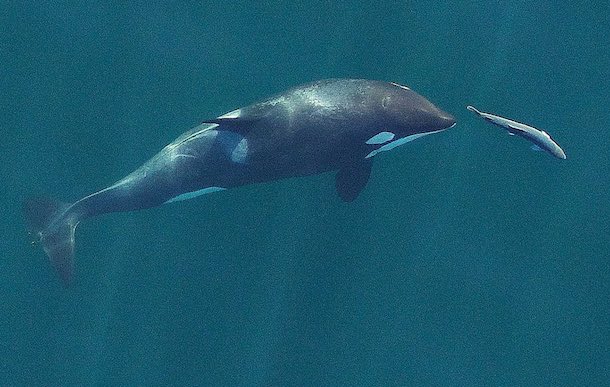forum
library
tutorial
contact

As the Chinook Go, So Go the Orcas
by Peggy AndersonSeattle Post-Intelligencer, April 5, 2006
|
the film forum library tutorial contact |

|
As the Chinook Go, So Go the Orcasby Peggy AndersonSeattle Post-Intelligencer, April 5, 2006 |
More PBDEs seen; adults often share fish with young
 SEATTLE -- The killer whales that chase salmon in this region's inland waters feed almost exclusively on chinook, to the extent that the orca population ebbs and flows right along with that of the West Coast's largest and longest-lived salmon, researchers said Tuesday.
SEATTLE -- The killer whales that chase salmon in this region's inland waters feed almost exclusively on chinook, to the extent that the orca population ebbs and flows right along with that of the West Coast's largest and longest-lived salmon, researchers said Tuesday.
The whales settle for chum salmon for six to eight weeks in the fall, when most of the chinook are gone, John Ford of Canada's Department of Fisheries and Oceans said at the 2006 Symposium on Southern Resident Killer Whales, a joint effort of his agency and the U.S. National Marine Fisheries Service.
Between 1996 and 2001, Ford said, sharp drops in the region's chinook runs correlated with declines in the northern and southern resident orca populations, as the inland killer whales of Canada and the United States are called.
Orca mortality was 300 percent higher than expected, Ford said, and difficult to link to other known stressors.
"It was a bit of a surprise to us," he said.
Both the U.S. and Canadian orca populations have been declared endangered, and the findings suggest salmon managers may want to set aside some chinook for the whales, he said.
"Chinook are what drive these animals," Ford said, even when other seemingly adequate salmon species may be far more abundant.
Many of the region's salmon runs are also considered endangered.
Killer whales may have come to prefer chinook over the centuries because the runs extend from April through October, he said. They spawn at different ages, and non-migratory chinook can be found in the area year-round. Chinook live as long as six years, longer than other salmon species, and can weigh up to 70 pounds. They also are fattier than other salmon species.
"I came in here today thinking killer whales would eat the salmon that were most abundant, but I'm finding that's not the case," said salmon researcher Jeff Haymes of the Washington state Department of Fish and Game, who also spoke about chinook populations at the second day of the three-day conference.
Longtime orca researcher Ken Balcomb of the Center for Whale Research addressed the mystery of where the resident orcas spend the winter months. The southern residents have been seen as far south as Monterey, Calif., and as far north as Canada's Queen Charlotte Islands.
"Now I know they hang around the core area till the chum run out ... and then go work chinook out on the coast," he said, laughing.
Defining orca habitat for protection is one of the tasks faced by NMFS under the Endangered Species Act.
"It's a moving target," Balcomb said.
When chinook numbers are down, orcas work harder to find them, said University of Washington researcher Shannon McCluskey, who studied orca movements and population in relation to salmon populations.
In the late 1990s, when runs were down, orcas spread out beyond the San Juan Islands, where the state's three resident orca pods are based. In the early '90s, when chinook numbers were up, they stayed closer to home.
Orcas, actually a kind of dolphin found in all the world's oceans, feed on 200 prey species, Ford said. Transient orcas, which live along the coast, prefer marine mammals. Offshore orcas mostly eat fish, including sharks.
Other researchers spoke about pollution threats from toxins such as long-lasting PCBs, or polychlorinated biphenyls, which have been banned since the 1970s but persist in orcas and other top predators; and fire-retardant PBDEs, polybrominated diphenyl ethers, which are still produced.
The impact of vessel traffic also was addressed.
Related Sites:
Fisheries Canada: www.pac.dfo-mpo.gc.ca
National Marine Fisheries Service: www.nwr.noaa.gov
Orca Network: www.orcanetwork.org
learn more on topics covered in the film
see the video
read the script
learn the songs
discussion forum
